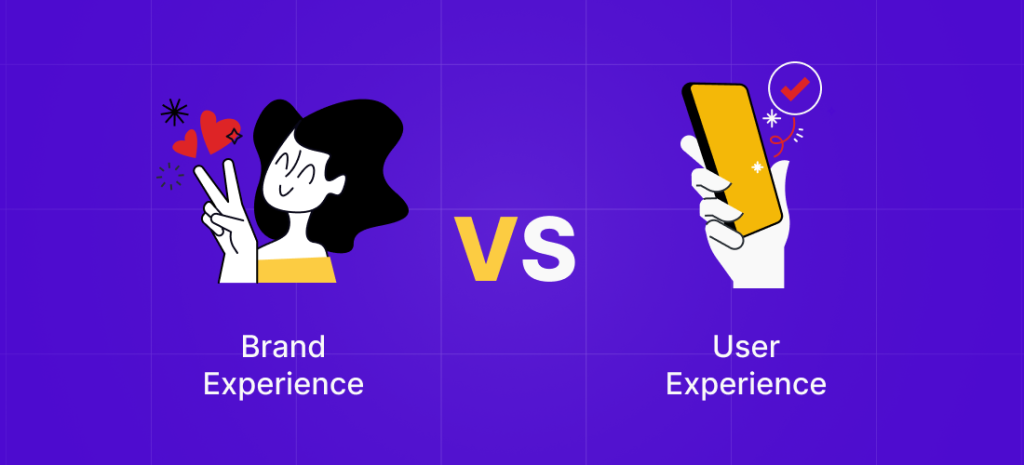When it comes to products and services in the current market, we are constantly bombarded with choices, and our purchasing decisions are increasingly influenced by brand experience. Brand experience covers each point of interaction that a customer has with your brand, from the moment they discover you to their ongoing interactions with your products, services, and customer support. Building a positive and memorable brand experience helps generate and maintain brand loyalty, driving customer engagement, and ultimately achieving sustainable growth for your brand.
Let’s take a look at what brand experience entails, exploring its key elements, its distinction from user experience (UX), and why it should be at the forefront of your brand strategy.
What is Brand Experience?
Brand experience refers to the total of all the perceptions, feelings, and emotions a customer goes through in their journey with your brand. It covers a wide range of interactions, both offline and online, including:
- Product Experience: The quality, functionality, and user-friendliness of your product or service.
- Marketing and Advertising: The tone, messaging, and overall presentation of your brand across marketing channels.
- Customer Service: The interactions a customer has with your customer support team, including their helpfulness, responsiveness, and ability to resolve issues.
- Website and Social Media Presence: The design, usability, and content of your website and social media platforms.
- Packaging and Branding: The visual identity and presentation of your products, including packaging design and logo.
- In-Store Experience: The layout, atmosphere, and customer service within your physical stores.
- Brand Community and Events: The sense of community fostered by your brand and any events you host that connect with customers on a deeper level.
Brand experience is not just about a single interaction; it’s about the complete journey a customer takes with your brand. A positive and seamless experience at every stage builds trust and loyalty, and gains organic word-of-mouth marketing for your brand.
The Elements of Brand Experience

Several aspects come together to create a brand experience and if done well with expertise, it creates a lasting impact of your brand on the consumers. The following are the basic elements of brand experience:
- Brand Identity: This means your brand’s core values, mission statement, visual identity (logo, colors, fonts), and overall brand personality. A well-defined brand identity forms the foundation for a consistent brand experience across all touchpoints.
- Customer Empathy: Understanding your target audience’s needs, desires, and pain points is crucial for crafting a brand experience that resonates with them.
- Emotional Connection: The best brand experiences evoke emotions in customers, fostering a sense of connection and brand loyalty. It’s all about creating an emotional bond that goes beyond just a product or service.
- Sensory Engagement: Engaging all five senses can create a more memorable brand experience. This could involve using visual elements, music, scent marketing, or interactive experiences in your stores or digital platforms. Think ‘You’re lovin’ it!’ from McDonalds.
- Storytelling: Humans connect with stories. Weaving a compelling narrative around your brand, its values, and its impact creates a deeper connection with customers.
- Consistency: Maintaining consistency across all touchpoints is vital. This ensures that the brand experience customers encounter is seamless, regardless of whether they interact with your brand online, in-store, or through customer service.
Brand Experience v/s User Experience

While both brand experience (BX) and user experience (UX) are crucial aspects of customer interaction, they approach a customer’s journey with your brand from different perspectives. Here are the subtle yet significant differences between these two concepts:
Brand Experience (BX):
- Focus: The overall customer perception of your brand, encompassing emotions, feelings, and sensory aspects.
- Scope: Broader, encompassing all touchpoints a customer has with your brand, both online and offline. This includes marketing messages, product interactions, customer service encounters, website usability, in-store experience, brand storytelling, and even packaging design.
- Goal: To create a lasting emotional connection with the customer, fostering brand loyalty and advocacy.
- Metrics: Customer satisfaction scores, net promoter score (NPS), brand sentiment analysis on social media, and brand recall surveys.
User Experience (UX):
- Focus: The usability and functionality of a specific product or service.
- Scope: Narrower, primarily concerned with how easy and enjoyable it is for a customer to interact with your product or service.
- Goal: To create a smooth, intuitive, and efficient experience that meets the user’s needs and expectations.
- Metrics: Usability testing results, task completion rates, time spent on tasks, user error rates, and customer feedback on product functionality.
Here’s an analogy to understand the difference:
Imagine a restaurant.
- Brand Experience: The ambiance, the service, the quality of the food, the overall feeling you get from dining there. These elements contribute to a positive or negative brand experience.
- User Experience: The ease of reading the menu, the comfort of the chairs, the efficiency of the ordering process. These aspects influence the user experience of dining at the restaurant.
Key Differences to Remember:
- Emotional vs. Functional: Brand experience evokes emotions and creates a feeling, while UX focuses on the functional aspects of using a product or service.
- Holistic vs. Specific: Brand experience encompasses the entirety of a customer’s journey, while UX is specific to a particular interaction or touchpoint.
- Indirect vs. Direct Impact: Positive UX can contribute to a positive brand experience, but it’s not the sole factor. Conversely, a negative brand experience can overshadow a positive UX.
The Synergy Between BX and UX:
- UX is the foundation of BX: A user-friendly product with a frustrating ordering process can negatively impact the brand experience.
- BX elevates UX: A brand experience that resonates with customers can make them more forgiving of minor usability issues.
Why Brand Experience Matters
Every business aims to not just gain new consumers, but also ensure they retain the existing ones. Brand experience is what ensures both of these parameters for success. A positive brand experience can be the deciding factor that sets you apart from the competition and drives customer loyalty. Here are some compelling reasons why brand experience matters:
- Increased Customer Loyalty: Positive brand experiences foster loyalty, encouraging customers to choose your brand repeatedly and recommend it to others.
- Enhanced Brand Advocacy: Loyal customers become brand advocates, sharing their positive experiences with others through word-of-mouth marketing and online reviews
- Boosts Customer Engagement: Positive brand experiences encourage customers to interact with your brand more frequently, whether it’s visiting your website, following you on social media, or attending your events.
- Premium Price Justification: A strong brand experience can justify premium pricing, as customers are willing to pay more for a brand they trust and value.
- Differentiates Your Brand: In a crowded marketplace, a well-crafted brand experience can set you apart from the competition and make your brand more memorable.
- Builds Brand Equity: Positive brand experiences contribute to overall brand equity, which is the intangible value associated with your brand name and reputation.
- Attracts Top Talent: A strong brand experience can attract talented individuals who want to work for a company with a positive reputation and culture.
- Positive Impact on Customer Lifetime Value (CLV): By fostering loyalty and repeat business, a positive brand experience can significantly increase a customer’s lifetime value (CLV), which is the total revenue a customer generates throughout their relationship with your brand.
Investing in brand experience is not just an additional expense; it’s a strategic investment in the future of your business. By prioritizing positive customer experiences at every touchpoint, you can reap the rewards of increased loyalty, brand advocacy, and sustainable growth.
Strategies for Impactful Brand Experience

Brand experience is all about focusing on how the customer interacts with each aspect of the brand and feels about that interaction. This requires careful consideration of the different dimensions that make up your brand. Here are some key strategies to consider:
- Define Your Brand Identity: Develop a clear and concise brand identity that resonates with your target audience. This forms the foundation for a consistent brand experience across all touchpoints.
- Know Your Customer: Conduct thorough market research and customer persona development to understand your target audience’s needs, desires, and pain points.
- Map the Customer Journey: Identify all the touchpoints a customer has with your brand, from discovery to purchase and beyond. Analyze each touchpoint and identify areas for improvement.
- Focus on Customer Empathy: Empathize with your customers’ challenges and frustrations. Strive to create solutions and experiences that address their needs and exceed their expectations.
- Invest in Customer Service: Train your customer service team to be helpful, responsive, and empathetic. They play a crucial role in shaping customer perception and brand experience.
- Embrace Storytelling: Weave a compelling narrative around your brand, its values, and its impact on customers’ lives. Stories connect with people on an emotional level and create a deeper brand connection.
- Optimize the Digital Experience: Ensure your website and social media platforms are user-friendly, visually appealing, and optimized for mobile devices.
- Personalize the Experience: Utilize data analytics and customer insights to personalize the customer experience whenever possible. This could involve targeted marketing messages, product recommendations, or loyalty programs.
- Create Emotional Connections: Develop marketing campaigns and content that evoke emotions and resonate with your target audience.
- Engage Through Multiple Channels: Be present on the platforms where your target audience is active. Create engaging content and foster interaction across various channels – website, social media, email marketing, etc.
- Be Data-Driven: Track key metrics related to your brand experience, such as customer satisfaction scores, net promoter score (NPS), and social media engagement. Use this data to identify areas for improvement and measure the effectiveness of your brand experience efforts.
- Invest in Employee Training: Empower your employees to deliver exceptional customer service and embody the brand values in their interactions with customers.
By implementing these strategies, you can develop a brand experience that sets you apart from the competition and builds lasting connections with your customers.
Examples of Effective Brand Experience

Brand experience isn’t just about a fleeting moment; it’s about creating a lasting impression that fosters customer loyalty and brand advocacy. Here are five examples of companies renowned for their impactful brand experiences, along with the secrets behind their success and the reasons for their longevity:
-
Disney: Weaving Magic Through Storytelling and Immersion
- Why it Works: Disney excels at creating immersive and emotionally charged experiences across all touchpoints. From stunning theme parks and captivating movies to interactive websites and engaging social media content, Disney focuses on storytelling. They weave narratives that resonate with people of all ages, transporting them to fantastical worlds and evoking a sense of wonder. Their meticulous attention to detail, exceptional customer service, and commitment to exceeding expectations solidify the positive brand experience.
- Cause of Longevity: Disney understands that creating memories is key to building lasting connections. Their ability to constantly innovate and adapt their stories while maintaining their core values ensures their brand remains relevant and cherished across generations.
-
Apple: Seamless Integration and User-Centric Design
- Why it Works: Apple is synonymous with sleek design, intuitive user experience, and a seamless integration of hardware and software. Their retail stores are designed to be welcoming and informative, creating a positive and personalized experience for customers. Apple prioritizes user feedback and consistently innovates, ensuring their products are not just aesthetically pleasing but also functional and user-friendly.
- Cause of Longevity: Apple cultivates a strong sense of brand loyalty by understanding their customers’ needs and exceeding expectations. They build trust through premium quality products and a commitment to user privacy. The Apple brand represents a status symbol and a commitment to innovation, fostering a long-lasting connection with their customers.
-
: Disruption, Affordability, and Playful Engagement
- Why it Works: Warby Parker disrupted the eyewear industry with their innovative online try-on experience and focus on affordability and design. They prioritize customer service and build brand loyalty through their playful and engaging social media presence. Their brand experience is refreshingly transparent and authentic, resonating with a young and tech-savvy audience.
- Cause of Longevity: Warby Parker challenges the status quo, making high-quality eyewear accessible and affordable. They prioritize customer satisfaction with hassle-free returns and exchanges. Their dedication to social responsibility, partnering with charities to provide vision care in underserved communities, further strengthens their brand image and fosters customer loyalty.
-
Patagonia: Environmental Advocacy and Building a Community
- Why it Works: Patagonia is a prime example of a brand that aligns its values with action. They are a vocal advocate for environmental protection and sustainability, which resonates deeply with a growing segment of eco-conscious consumers. Their products are high-quality and built to last, aligning with their commitment to environmental responsibility. Patagonia fosters a sense of community through events, workshops, and online forums, creating a connection that goes beyond just selling outdoor gear.
- Cause of Longevity: Patagonia prioritizes long-term value over fast fashion. Their commitment to sustainability and ethical sourcing resonates with environmentally conscious consumers. Building a community around shared values fosters customer loyalty and a sense of belonging, ensuring the brand remains rel evant for generations dedicated to a healthy planet.
-
LEGO: Building Creativity and Memories Across Generations
- Why it Works: LEGO transcends generations by providing an engaging and open-ended platform for creativity and play. Their sets spark imagination and encourage problem-solving skills in children and adults alike. LEGO actively engages with their audience through interactive online experiences, engaging stories, and fan-built creations.
- Cause of Longevity: LEGO taps into the power of nostalgia, allowing adults to reconnect with their childhood memories and share them with a new generation. Their consistent focus on quality and innovation ensures the brand remains relevant and exciting for generations to come. Their commitment to responsible sourcing and sustainability further cements their place as a cherished brand for families.
These examples showcase the diverse ways brands can create impactful experiences. Whether it’s through storytelling, user-centric design, social responsibility, a sense of community, or fostering creativity, the key lies in understanding your audience and crafting a brand experience that resonates with their values and emotional needs.
Conclusion
By understanding the core elements of brand experience, its distinction from UX, and the compelling reasons why it matters, you can embark on the journey of creating a brand that resonates with your customers and fosters lasting loyalty.





